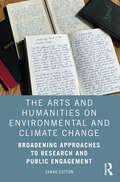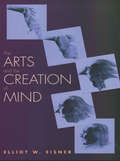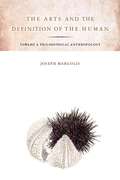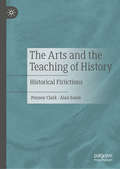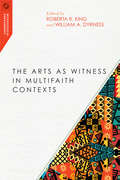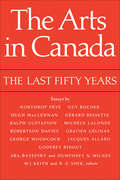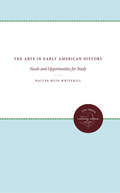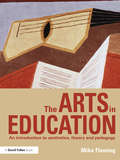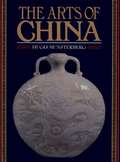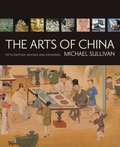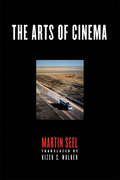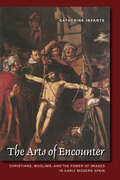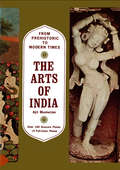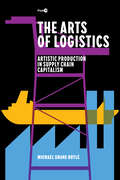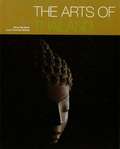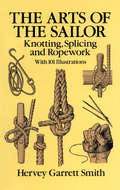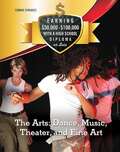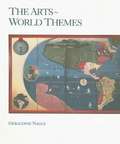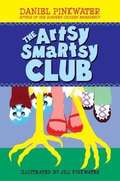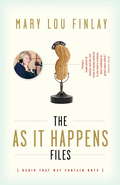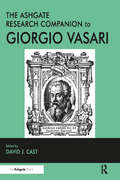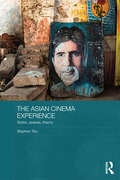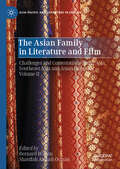- Table View
- List View
The Arts and Humanities on Environmental and Climate Change: Broadening Approaches to Research and Public Engagement
by Sarah SuttonThe Arts and Humanities on Environmental and Climate Change examines how cultural institutions and their collections can support a goal shared with the scientific community: creating a climate-literate public that engages with environmental issues and climate change in an informed way. When researchers, curators, and educators use the arts and humanities to frame discussions about environmental and climate change, they can engage a far wider public in learning, conversation, and action than science can alone. Demonstrating that archival and object-based resources can act as vital evidence for change, Sutton shows how the historical record, paired with contemporary reality, can create more personal connections to what many consider a remote experience: the changing climate. Providing valuable examples of museum collections used in discussions of environmental and climate change, the book shares how historic images and landscape paintings demonstrate change over time; and how documentary evidence in the form of archaeological reports, ships logs, Henry David Thoreau’s journals, and local reports of pond hockey conditions are being used to render climate data more accessible. Images, personal records, and professional documents have critical roles as boundary objects and proxy data. These climate resources, Sutton argues, are valuable because they make climate change personal and attract a public less interested in a scientific approach. This approach is underused by museums and their research allies for public engagement and for building institutional relevancy. The Arts and Humanities on Environmental and Climate Change will be most interesting to readers looking for ways to broaden engagement with environmental and climate issues. The ideas shared here should also act as inspiration for a broad spectrum of practitioners, particularly those writing, designing, and curating public engagement materials in museums, for wider research, and for the media.
The Arts and the Creation of Mind
by Elliot W. EisnerAlthough the arts are often thought to be closer to the rim of education than to its core, they are, surprisingly, critically important means for developing complex and subtle aspects of the mind, argues Elliot Eisner in this engrossing book. In it he describes how various forms of thinking are evoked, developed, and refined through the arts. These forms of thinking, Eisner argues, are more helpful in dealing with the ambiguities and uncertainties of daily life than are the formally structured curricula that are employed today in schools. Offering a rich array of examples, Eisner describes different approaches to the teaching of the arts and the virtues each possesses when well taught. He discusses especially nettlesome issues pertaining to the evaluation of performance in the arts. Perhaps most important, Eisner provides a fresh and admittedly iconoclastic perspective on what the arts can contribute to education, namely a new vision of both its aims and its means. This new perspective, Eisner argues, is especially important today, a time at which mechanistic forms of technical rationality often dominate our thinking about the conduct and assessment of education.
The Arts and the Definition of the Human
by Joseph MargolisThe Arts and the Definition of the Humanintroduces a novel theory that our selves-our thoughts, perceptions, creativity, and other qualities that make us human-are determined by our place in history, and more particularly by our culture and language. Margolis rejects the idea that any concepts or truths remain fixed and objective through the flow of history and reveals that this theory of the human being (or "philosophical anthropology") as culturally determined and changing is necessary to make sense of art. He shows that a painting, sculpture, or poem cannot have a single correct interpretation because our creation and perception of art will always be mitigated by our historical and cultural contexts. Calling upon philosophers ranging from Parmenides and Plato to Kant, Hegel, and Wittgenstein, art historians from Damisch to Elkins, artists from Van Eyck to Michelangelo to Wordsworth to Duchamp, Margolis creates a philosophy of art interwoven with his philosophical anthropology which pointedly challenges prevailing views of the fine arts and the nature of personhood.
The Arts and the Teaching of History: Historical F(r)ictions
by Alan Sears Penney ClarkThis book closely examines the pedagogical possibilities of integrating the arts into history curriculum at the secondary and post-secondary levels. Students encounter expressions of history every day in the form of fiction, paintings, and commemorative art, as well as other art forms. Research demonstrates it is often these more informal encounters with history that define students’ knowledge and understandings rather than the official accounts present in school curricula. This volume will provide educators with tools to bring together these parallel tracks of history education to help enrich students’ understandings and as a mechanism for students to present their own emerging historical perspectives.
The Arts as Witness in Multifaith Contexts (Missiological Engagements)
by William A. Dyrness Roberta R. KingIn search of holistic Christian witness, missionaries have increasingly sought to take into account all the dimensions of people's cultural and religious lives—including their songs, dances, dramatic performances, storytelling, and visual arts.
The Arts in Canada: The Last Fifty Years
by William Keith Ben-Z. ShekIn this volume a baker's dozen of creative Canadians make personal responses to the state of the arts in Canada: Northrop Frye and Guy Rocher write on general cultural trends; Hugh MacLennan and Gérard Bessette on fiction; Ralph Gustafson and Michèle Lalonde on poetry; Robertson Davies and Gratien Gélinas on drama; George Woodcock and Jacques Allard on non-fiction prose; Godfrey Ridout on music, and Aba Bayefsky and Humphrey N. Milnes on art. The essays were written to mark the fiftieth anniversary of the University of Toronto Quarterly. The contributors were invited to discuss the changes, problems, challenges, and achievements in the arts in the last fifty years. Since all the authors had personal experience of at least a large section of the period surveyed, the editors welcomed personal reminiscence as well as description and assessment. The result is a varied group of essays in each of which the character of the individual artist is clearly evident; together, they provide a complex, many-faceted, lively, and living discussion of the cultural development of Canada. This anniversary collection of essays is a valuable and provocative source for courses in Canadian studies and for anyone interested in the development of the arts and humanities in Canada.
The Arts in Early American History: Needs and Opportunities for Study (Published by the Omohundro Institute of Early American History and Culture and the University of North Carolina Press)
by Walter Muir WhitehillThis summary essay and the heavily annotated bibliography covering the period from the first colonization to 1826 are primarily intended to aid the scholar and student by suggesting areas of further study and ways of expanding the conventional interpretations of early American history.Originally published in 1935. <br> A UNC Press Enduring Edition -- UNC Press Enduring Editions use the latest in digital technology to make available again books from our distinguished backlist that were previously out of print. These editions are published unaltered from the original, and are presented in affordable paperback formats, bringing readers both historical and cultural value.
The Arts in Education: An introduction to aesthetics, theory and pedagogy
by Mike FlemingDo the arts improve academic achievement? What does it mean to ‘teach’ art? What should the balance of classic and pop be in the music curriculum? Should we encourage young children on the stage? How do we judge whether what a child produces is good? How do we justify the arts in the curriculum? What should be the balance between form and content when teaching art? The arts in education inspire considerable commitment and passion. However, this is not always matched by clarity of understanding. In this book Mike Fleming introduces the reader to key theoretical questions associated with arts education and clearly explains how these are related to practice. It offers an authoritative account of how ideas relevant to education are addressed by key authors in aesthetics, art theory and cultural studies. Covering all aspects of arts education, the book considers: definitions and theories of art influences on teaching the arts researching the arts teaching and learning creativity assessment. Throughout the book there are examples of practice to illustrate key ideas and a discussion of useful background texts with a summary of content and arguments for further exploration. Written by a leading authority in the field, it is essential reading for students on Arts PGCE and M Level courses, teachers of the arts and policy developers that require more understanding and insight into their practice.
The Arts of China
by Hugo MunsterbergThe arts of China are products of the world's oldest continuous artistic tradition as well as one of its most brilliant. In this stimulating work, noted Oriental art authority Dr. Hugo Munsterberg traces the history of Chinese art dynasty by dynasty, elucidating the origins and development of major movements in painting, ceramics, bronzes, sculpture, and architecture. He clearly describes and defines the important trends and influences that culminated in the brilliant sculpture of the T'ang, the enchanting landscape paintings of the Sung, and the exquisite ceramics of the Ming. Outstanding examples of each genre are presented in over one hundred superb color and black-and-white photographs.
The Arts of China
by Hugo MunsterbergThe arts of China are products of the world's oldest continuous artistic tradition as well as one of its most brilliant. In this stimulating work, noted Oriental art authority Dr. Hugo Munsterberg traces the history of Chinese art dynasty by dynasty, elucidating the origins and development of major movements in painting, ceramics, bronzes, sculpture, and architecture. He clearly describes and defines the important trends and influences that culminated in the brilliant sculpture of the T'ang, the enchanting landscape paintings of the Sung, and the exquisite ceramics of the Ming. Outstanding examples of each genre are presented in over one hundred superb color and black-and-white photographs.
The Arts of China (Fifth Revised and Expanded Edition)
by Michael SullivanFor the fourth edition of his much-heralded The Arts of China, last published in 1984, Michael Sullivan has thoroughly revised and expanded this classic history of Chinese art from the Neolithic period to the 1990s. He draws on archaeological discoveries in the last two decades of the twentieth century that have enriched scholars' understanding of both prehistoric and ancient Chinese civilizations. At the same time, research on more recent dynasties has led to fresh interpretations of well-documented historical events and artworks. Also, China's dramatic opening to the outside world since the 1980s has triggered an explosion of contemporary Chinese art, on which Sullivan is the foremost Western authority. Written in the engaging and lucid style that is Sullivan's hallmark, The Arts of China is readily accessible to general readers as well as serious students of art history. Discussing more than three millennia of Chinese artistic endeavor, Sullivan introduces not only artworks, but also the social, political, religious, and philosophical contexts in which they were created. This fourth edition has more than 380 illustrations; many are new and nearly half are in color. With this edition Sullivan has abandoned the Wade-Giles system of romanization in favor of the official Chinese Pinyin, now widely accepted by Western readers. These improvements assure that The Arts of China will remain the most comprehensive and widely read introduction to the history of Chinese art. For the fourth edition of his much-heralded The Arts of China, last published in 1984, Michael Sullivan has thoroughly revised and expanded this classic history of Chinese art from the Neolithic period to the 1990s. He draws on archaeological discoveries in the last two decades of the twentieth century that have enriched scholars' understanding of both prehistoric and ancient Chinese civilizations. At the same time, research on more recent dynasties has led to fresh interpretations of well-documented historical events and artworks. Also, China's dramatic opening to the outside world since the 1980s has triggered an explosion of contemporary Chinese art, on which Sullivan is the foremost Western authority. Written in the engaging and lucid style that is Sullivan's hallmark, The Arts of China is readily accessible to general readers as well as serious students of art history. Discussing more than three millennia of Chinese artistic endeavor, Sullivan introduces not only artworks, but also the social, political, religious, and philosophical contexts in which they were created. This fourth edition has more than 380 illustrations; many are new and nearly half are in color. With this edition Sullivan has abandoned the Wade-Giles system of romanization in favor of the official Chinese Pinyin, now widely accepted by Western readers. These improvements assure that The Arts of China will remain the most comprehensive and widely read introduction to the history of Chinese art.
The Arts of Cinema
by Martin SeelIn The Arts of Cinema, Martin Seel explores film’s connections to the other arts and the qualities that distinguish it from them. In nine concise and elegantly written chapters, he explores the cinema’s singular aesthetic potential and uses specific examples from a diverse range of films—from Antonioni and Hitchcock to The Searchers and The Bourne Supremacy—to demonstrate the many ways this potential can be realized. Seel’s analysis provides both a new perspective on film as a comprehensive aesthetic experience and a nuanced understanding of what the medium does to us once we are in the cinema.
The Arts of EncounterThe Arts of Encounter: Christians, Muslims, and the Power of Images in Early Modern Spain (Toronto Iberic)
by Catherine InfanteImages of crosses, the Virgin Mary, and Christ, among other devotional objects, pervaded nearly every aspect of public and private life in early modern Spain, but they were also a point of contention between Christian and Muslim cultures. Writers of narrative fiction, theatre, and poetry were attuned to these debates, and religious imagery played an important role in how early modern writers chose to portray relations between Christians and Muslims. Drawing on a wide variety of literary genres as well as other textual and visual sources – including historical chronicles, travel memoirs, captives’ testimonies, and paintings – Catherine Infante traces the references to religious visual culture and the responses they incited in cross-confessional negotiations. She reveals some of the anxieties about what it meant to belong to different ethnic or religious communities and how these communities interacted with each other within the fluid boundaries of the Mediterranean world. Focusing on the religious image as a point of contact between individuals of diverse beliefs and practices, The Arts of Encounter presents an original and necessary perspective on how Christian-Muslim relations were perceived and conveyed in print.
The Arts of India
by Ajit MookerjeeThis revised and enlarged edition of The Arts of India has over 150 impressive gravure and full-color illustrations. These include various important objects and monuments not usually seen in general surveys to supplement the many essential art milestones that this book features. It is also unique in beginning its visual survey with relics of India's stone age and in concluding the book with works from the nation's great folk tradition and selected paintings by modern artists.Here is a book with captions and a text that are highly readable blends of scholarly information and informal comment by an Indian art expert. This grants the reader special insights into the concepts that lie behind art so different from that of the West.Author Mookerjee has judiciously selected photographs which present the vast panorama of Indian art from its earliest beginnings. Examples of Indian folk arts and some works by 20th-century Indian artists round out this rich historic survey of over 5,000 years of continuous creativity-a collection of paintings, reliefs, statues, and architectural monuments from this sprawling sub-continent now divided into the lands of India, Pakistan, Ceylon, Burma and Afghanistan.
The Arts of Indigenous Health and Well-Being
by Edited by Nancy Van Styvendale;J.D. McDougall;Robert Henry;and Robert Alexander InnesDrawing attention to the ways in which creative practices are essential to the health, well-being, and healing of Indigenous peoples, The Arts of Indigenous Health and Well-Being addresses the effects of artistic endeavour on the “good life”, or mino-pimatisiwin in Cree, which can be described as the balanced interconnection of physical, emotional, spiritual, and mental well-being. In this interdisciplinary collection, Indigenous knowledges inform an approach to health as a wider set of relations that are central to well-being, wherein artistic expression furthers cultural continuity and resilience, community connection, and kinship to push back against forces of fracture and disruption imposed by colonialism. The need for healing—not only individuals but health systems and practices—is clear, especially as the trauma of colonialism is continually revealed and perpetuated within health systems. The field of Indigenous health has recently begun to recognize the fundamental connection between creative expression and well-being. This book brings together scholarship by humanities scholars, social scientists, artists, and those holding experiential knowledge from across Turtle Island to add urgently needed perspectives to this conversation. Contributors embrace a diverse range of research methods, including community-engaged scholarship with Indigenous youth, artists, Elders, and language keepers. The Arts of Indigenous Health and Well-Being demonstrates the healing possibilities of Indigenous works of art, literature, film, and music from a diversity of Indigenous peoples and arts traditions. This book will resonate with health practitioners, community members, and any who recognize the power of art as a window, an entryway to access a healthy and good life.
The Arts of Logistics: Artistic Production in Supply Chain Capitalism (Post*45)
by Michael Shane BoyleWe live in a world where nothing is untouched by supply chains—art included. In this major contribution to the study of contemporary culture and supply chains, Michael Shane Boyle has assembled a global inventory of aesthetics since the 1950s that reveals logistics to be a pervasive means of artistic production. The Arts of Logistics provides a new map of supply chain capitalism, scrutinizing how artists retool technologies designed for circulating commodities. What emerges is a magisterial account of the logistics revolution that foregrounds the role played by art in the long downturn of global capitalism. With chapters on art produced from technologies including ships, barrels, containers, and drones, Boyle narrates the long history of art's connection to logistics, beginning in the transatlantic slave trade and continuing today in Silicon Valley's dreams of automation. The global reach of the artists considered reflects the geographies of supply chain capitalism itself. In taking stock of how performance, sculpture, and popular culture are entangled in trade and racialized labor regimes, Boyle profiles influential work by artists such as Christo and Allan Kaprow alongside that of contemporary figures including Cai Guo-Qiang and Selina Thompson. This incisive study demonstrates that art and logistics are linked by the infrastructures and violence that keep supply chains moving.
The Arts of Thailand
by Luca Invernizzi Tettoni Steve Van BeekFor over a thousand years, Thailand has been a cultural crossroads for the artistic traditions of India, Sri Lanka, Cambodia, and Indonesia, gradually evolving a unique style of artistic expression all its own. Based on exhaustive museum, library, and temple research, The Arts of Thailand covers every major form and period of Thai art and provides a complete overview of one of the world's richest artistic traditions.
The Arts of the Sailor: Knotting, Splicing and Ropework
by Hervey Garrett SmithOver 150 years ago, the skills needed to operate a merchant sailing vessel were many and varied. While not nearly as much in demand today as they were in the days of the Yankee clippers, these skills nevertheless remain important and necessary to today's yachtsmen and owners of smaller pleasure boats.In this excellent handbook on basic shipboard skills, marine expert Hervey Garrett Smith offers boating and yachting enthusiasts a complete course in rigging, working, and maintaining a ship. More than 100 illustrations help the reader grasp the fundamentals and fine points of handling a ship while the author describes in detail a sailor's tools, basic knots, and useful hitches as well as the arts of splicing, handsewing, and canvas work.Other topics equally important to safe, economical, and efficient boat maintenance and management include belaying, coiling, and stowing; towing procedures; how to make a chafing gear; and much more. Easy-to-follow instructions for fashioning decorative knots, ornamental coverings, and nettings, and even how to make a proper bucket round out this engaging and informative guide.Packed with useful "hands-on" information conveyed in a chatty, humorous style, The Arts of the Sailor is the perfect book to keep aboard ship for study and for ready reference when the need arises. It also makes delightful reading for armchair sailors and the legions of landlubbers with an interest in the sea.
The Arts: Dance, Music, ater, and Fine Art (Earning $50,000 - $100,000 with a High S)
by Connor SyrewiczFor many high school graduates, college is a way to get ahead, but going to college is not the only way for young adults to succeed. Many people choose to enter the workforce after high school to start earning money and gaining experience right away. These motivated young workers can have rewarding jobs without ever having to earn a 4-year college degree. If you're interested in music, theater, or art, and don't know that you want to--or can--go to college, a career in the arts might be right for you. Young people need only a high school diploma or equivalent to start work in a career in the arts, and they can eventually earn more than $50,000 a year. In The Arts: Dance, Music, Theater and Fine Art, you'll learn how to start a career in the arts and what you need to succeed in the field. Find out about the prospects for these careers in the future, how much workers can make each year, and whether your path to success includes a career in music, theater, dance, or fine art.
The Arts: World Themes
by Geraldine NagleA fresh approach to the interdisciplinary humanities course that takes a strong multicultural approach to the visual and performing arts. Organized thematically, the text covers painting, printmaking, sculpture, camera arts, architecture, music, and drama.
The Artsy Smartsy Club
by Daniel PinkwaterAfter three Hoboken children and their giant chicken Henrietta begin to appreciate beautiful sidewalk art, they venture into art class and visit Manhattan.
The As It Happens Files
by Mary Lou FinlayIn the tradition of Peter Gzowski's The Morningside Papers comes a book that celebrates the great stories and personalities behind As It Happens.For eight years, Mary Lou Finlay had the pleasure of being the co-host of one of CBC Radio's most enduring institutions. On any given day she and Barbara Budd interviewed people on subjects varying from the Air India investigation to a man who invented a suit that would withstand an attack from a grizzly bear to a cheese-rolling contest in Cheshire. The As It Happens Files gives us the great stories - the hilarious eccentrics, the audience favourites, the poignant moments - that make up, for many Canadians some of the fondest, most vivid memories of the last decade.
The Ashgate Research Companion to Giorgio Vasari (Routledge Art History and Visual Studies Companions)
by David J. CastThe Ashgate Research Companion to Giorgio Vasari brings together the world's foremost experts on Vasari as well as up-and-coming scholars to provide, at the 500th anniversary of his birth, a comprehensive assessment of the current state of scholarship on this important-and still controversial-artist and writer. The contributors examine the life and work of Vasari as an artist, architect, courtier, academician, and as a biographer of artists. They also explore his legacy, including an analysis of the reception of his work over the last five centuries. Among the topics specifically addressed here are an assessment of the current controversy as to how much of Vasari's 'Lives' was actually written by Vasari; and explorations of Vasari's relationships with, as well as reports about, contemporaries, including Cellini, Michelangelo and Giotto, among less familiar names. The geographic scope takes in not only Florence, the city traditionally privileged in Italian Renaissance art history, but also less commonly studied geographical venues such as Siena and Venice.
The Asian Cinema Experience: Styles, Spaces, Theory (Media, Culture and Social Change in Asia)
by Stephen TeoThis book explores the range and dynamism of contemporary Asian cinemas, covering East Asia (China, Japan, South Korea, Hong Kong, Taiwan), Southeast Asia (Thailand, Singapore, Malaysia), South Asia (Bollywood), and West Asia (Iran), in order to discover what is common about them and to engender a theory or concept of "Asian Cinema". It goes beyond existing work which provides a field survey of Asian cinema, probing more deeply into the field of Asian Cinema, arguing that Asian Cinema constitutes a separate pedagogical subject, and putting forward an alternative cinematic paradigm. The book covers "styles", including the works of classical Asian Cinema masters, and specific genres such as horror films, and Bollywood and Anime, two very popular modes of Asian Cinema; "spaces", including artistic use of space and perspective in Chinese cinema, geographic and personal space in Iranian cinema, the private "erotic space" of films from South Korea and Thailand, and the persistence of the family unit in the urban spaces of Asian big cities in many Asian films; and "concepts" such as Pan-Asianism, Orientalism, Nationalism and Third Cinema. The rise of Asian nations on the world stage has been coupled with a growing interest, both inside and outside Asia, of Asian culture, of which film is increasingly an indispensable component – this book provides a rich, insightful overview of what exactly constitutes Asian Cinema.
The Asian Family in Literature and Film: Challenges and Contestations-South Asia, Southeast Asia and Asian Diaspora, Volume II (Asia-Pacific and Literature in English)
by Bernard Wilson Sharifah Aishah OsmanThis book investigates the ways in which the family unit is now perceived in South and Southeast Asia and the Asian diaspora: its numerous conceptions and the changes it has undergone over the last century and into the new one. The prevailing threads that run through a significant part of the literature and cinema emerging from these societies are the challenges that confront those negotiating changing forms of family, changes which are expressed historically, politically, and socio-culturally, and often in relation to gender, ethnic, or economic imbalances. Though regional and localized in many ways, they are also very much universal in the questions they ask, the lessons they teach, and the connections they make. Theoretically, and in terms of focus, the collection offers a broad range, embracing representation and analysis from scholars across the globe and across disciplines. It assembles written and visual texts from and about India, Indonesia, Malaysia, The Philippines, Singapore, and the Asian diaspora. How have more fluid concepts of family in the late twentieth and early twenty-first centuries affected the understanding of family in Asia? How have families in Asia resisted or embraced change? How have they responded to trauma? What do other readings—gendered, feminist, queer, and diasporic—bring to modern debates surrounding family? To what extent are notions of family, community, society, and nation represented as interchangeable concepts in Asian societies? This book questions the power dynamics, ethical considerations, and moral imperatives that underpin families and societies within, and beyond, Asian borders.
